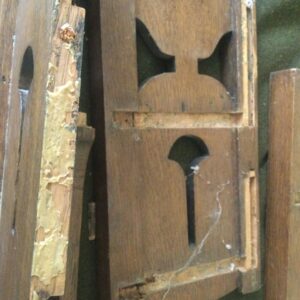I’ve inherited a potentially fine library table from family who acquired it in East Aurora NY, home of the Roycroft workshop, in the late 1960s. (Don’t think it’s a Roycroft piece due to construction methods and lack of mark.). It’s currently in pieces, and shows signs of inept repair, with lots of hardened glue, broken dowels, some splits. It is solid wood, though, and of fine quality quartersawn oak. Could someone point me in the direction of a good guide (book, website, magazine article) discussing how best to approach this kind of repair/restoration? I’m pretty handy in the workshop and have built furniture but would love to learn of any pitfalls in advance so I don’t do something dumb trying to figure things out as I go. Specifically removing old glue (physical scraping vs softening with water/vinegar/?), removing old dowels (do I over drill into clean wood or use cleaned out existing holes?). I don’t want to damage the wood or make a mistake that may compromise the stability of the piece when reassembled and in use. Thanks in advance to anyone who can point me in the direction of useful resources that I’m certain are out there.
Discussion Forum
Get It All!
UNLIMITED Membership is like taking a master class in woodworking for less than $10 a month.
Start Your Free TrialDiscussion Forum
Digital Plans Library
Member exclusive! – Plans for everyone – from beginners to experts – right at your fingertips.
Highlights
-
Shape Your Skills
when you sign up for our emails
This site is protected by reCAPTCHA and the Google Privacy Policy and Terms of Service apply. -
 Shop Talk Live Podcast
Shop Talk Live Podcast -
 Our favorite articles and videos
Our favorite articles and videos -
E-Learning Courses from Fine Woodworking
-













Replies
Most likely that is hide glue. I wouldnt go anywhere near that thing with vinegar for fear of discoloring the wood. Hide glue will soften at a little over 200 degrees so with steam or a heat gun at a low setting and a bunch of scrapers heating on ( I use) a hot plate you can scrape the glue clean. When one scraper goes cold on you another is ready to pick up. If it's hide glue then when I reglue I use hide glue. I use hot hide glue. There is also liquid hide glue available. I have a dubious opinion of liquid hide glue but maybe it's just snobbery because I don't have that much experience with it, but hot hide glue users seem to be united that liquid hide glue is inferior.
If you can't clean up the dowel holes to your satisfaction or cant get the old dowels out without causing a lot of distruction then you'll have to oversize. I'll turn new ones slightly oversize so that a 5/16" dowel becomes 21/32 etc. Or I use a piece of boiler plate and drill a hole at the desired diameter and drive a larger size dowel through the hole. I've even done that starting with square stock.
The finish appears to be ammoniated. You can do that but it requires a fair amount of set up and don't kill yourself! I would first try and clean it with naphtha and see where you are. Rule of thumb is if you refinish an antique you at least half the value. There are probably websites and YouTube videos about ammoniated finishes. The process is really simple. You take industrial strength ammonia and place it in a dish in an airtight environment with the table . Experience, yours or someone's determines how long to leave it.
I love watching this guy on YouTube. He's seen the Elephant and knows what he is doing.
Once you have watched a few of his videos, you will have a good idea of what you face
https://www.youtube.com/user/johnsonrestoration/videos
This forum post is now archived. Commenting has been disabled